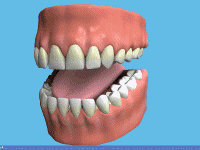 Tooth brushing is the single biggest factor dictating the health of your mouth – not how often you go to the dentist. As such, it is important that good habits are developed which become automatic. 2 minutes is now the normal advice for tooth brushing – brushing for this time will usually transform an unhealthy mouth.
Tooth brushing is the single biggest factor dictating the health of your mouth – not how often you go to the dentist. As such, it is important that good habits are developed which become automatic. 2 minutes is now the normal advice for tooth brushing – brushing for this time will usually transform an unhealthy mouth.
Electric brushes are excellent and are recommended, but they still need to be applied to all areas as would a manual brush.
Even the best brushers though will only clean 65% of their tooth surfaces with normal brushing. To clean those places which we cannot clean with a toothbrush, flossing with dental floss cut off a reel or in plastic holders (see video) is an excellent addition to normal brushing.
If you have bridgework, Superfloss from Oral B allows you to thread floss beneath the span of the bridge – this is very useful but if you don’t have bridgework, other floss is more suitable.
As we get older, changes to the gums and gum disease can cause the triangular point of gum between two teeth to flatten down (this is always much worse from smoking). This leaves a triangular space which can be very difficult to clean well. There are several ways of cleaning these areas including: flossing; single tufted brush; and, increasingly interdental Brushing is becoming very popular with patients.
Some patients, especially those who are worried about bad breath, may regularly cleanse their tongue. The surface of the tongue is made up of thousands of thin fingers, with spaces between them. Down between these fingers food particles and bacteria can remain and affect the odour or bacterial health of the mouth.






